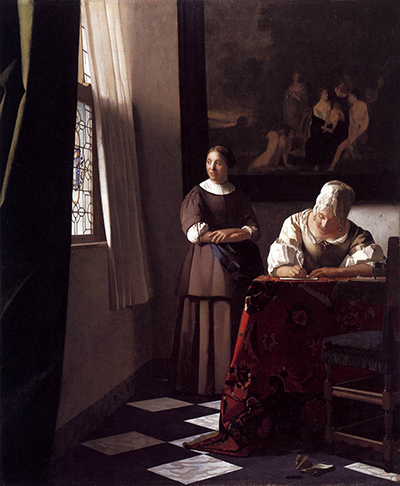The artwork Lady Writing a Letter with her Maid by Dutch artist Johannes Vermeer is dated back to 1671. The painter created his work near the end of his career as he died in 1675 at an unexpected death.
Johannes Vermeer's critical attention to detail holds the attention of viewers for centuries as they are captivated by his brilliant style exploring the Dutch Golden Age.
The painting illustrates a middle class woman seated at a table writing a letter as her maid accompanies her. The foundation of the piece is based on Vermeer's classic conservative style of artistry while incorporating a slight edge that explores the transitional form of the 1670's.
The painting is one of the first of the artist's where he explores a non-central frame for the painting by displacing the imagery in a different form.
The artist places the made in the middle of the frame, moving the woman to the right side of the canvas. This new style differs from Vermeer's classic illustration of characters within his art as they are always a centred focus.
Alongside, the placement of the made within the focal point of the artwork differs at Vermeer usually placed the dominant character in the middle. The exploration experiment with the centrifugal composition brings a new feel to Vermeer's work with a deeper message behind the artwork.
The wealthier woman is seated at a table near the left of the painting working on composing a letter with her head down. She is dressed in a beige flowing dress paired with white ruffles along her sleeve adding to the artwork.
The woman's is of an older age than the woman the artist had usually portrayed, with grey hair pinned upwards. Her older age however does not add to the sophistication of the woman as her significance is taken away and placed upon the maid. Yet, the woman writing the letter is seized by her task, having her maid at the side accompany her as she ponders her words.
Based on the placement of the artwork it is evident that the artist is placing the focal point of the painting on the maid standing at the centre of the frame.
The maid stands upright with her hands folded against the other as she waits for the woman to finish writing the letter. The woman stares at the window to the right of her, looking far into the distance as she ignores what is occurring with her master. The maid's gaze being lost outside of the mosaic window as she ponders her own life and events seizing the viewer.
Perhaps the woman is psychologically and emotionally exhausted by her job serving the woman, day dreaming as she stares outside. The maid's action of turning her head away seems to indicate an inner restlessness or contempt for her master.
The thought provoking artwork is a significant piece to note as it illustrates the transition of Vermeer heading towards the unknown through his work. The painting is a classic example of the immense layers of depth art carries through a simple canvas.
Similar artworks to the painting include The Love Letter, and Mistress and Maid.




